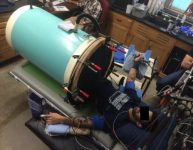
Summary:Cardiovascular decompensation is a significant risk after blood loss, even once the person is no longer actively bleeding. Applying a bag of ice to a person’s forehead could help prevent this life-threatening complication while patients are being transported to the hospital.
A new study suggests a simple bag of ice water applied to the face could help maintain adequate blood pressure in people who have suffered significant blood loss. Blair Johnson, PhD, assistant professor at the University at Buffalo, will present his team’s work at the American Physiological Society’s annual meeting during the Experimental Biology 2017 meeting, to be held April 22-26 in Chicago.
The researchers’ aim is to help prevent cardiovascular decompensation, a sudden precipitous drop in blood pressure that limits oxygen delivery to the heart, brain and other vital organs. Decompensation is a significant risk after blood loss, even once the person is no longer actively bleeding.
“We believe that cooling the face could potentially be used as a quick and temporary method to prevent cardiovascular decompensation after blood loss once active bleeding has stopped,” said Johnson. “We think that this technique could be used by first responders or combat medics on the battlefield to give additional time for transportation or evacuation.”
As a preliminary test of the technique, the researchers recruited 10 healthy volunteers, who were put into a special chamber that mimics what happens to blood circulation when a person has lost about one-half to one liter of blood and had a tourniquet applied to stop further blood loss. The researchers applied bags of either ice water or room-temperature water to the volunteers’ faces for 15 minutes while continuously measuring indicators of cardiovascular function.
Participants treated with the ice bag showed significant increases in blood pressure, suggesting that cooling the face could help bolster cardiovascular functioning after blood loss and prevent a dangerous fall in blood pressure.
Johnson cautioned that the technique is intended only for preventing cardiovascular decompensation after active bleeding has stopped, for example, by using a tourniquet. Increasing blood pressure during active bleeding could exacerbate blood loss.
After conducting more laboratory research to determine the environments and types of situations in which face cooling is most likely to be effective, the researchers hope to test the technique in a clinical trial.
More:Science







Leave a Reply
You must be logged in to post a comment.